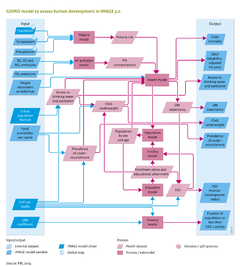Human development/Description: Difference between revisions
Jump to navigation
Jump to search
No edit summary |
No edit summary |
||
| Line 3: | Line 3: | ||
|Description=In the GISMO model, the impacts of global environmental change on human development are modelled by considering impacts on human health – either directly, for example, via the impact of climate change on malaria, or indirectly, such as by the impact of climate change on food availability. In addition to environmental factors, human health is also driven by socioeconomic factors, including income levels and educational attainment. To take account of these different factors and their interrelation, the GISMO model consists of three modules that address human health, poverty and education (see Figure on the right). The modules are linked through a cohort component population model, including endogenous fertility and mortality (for details see [[Hilderink, 2000]]). Fertility levels are modelled using a convergence level that is determined by female educational levels, and a speed of convergence, determined by the human development index ([[HDI (human development index)|HDI]]) (see below). Mortality rates are determined by the health module, which is discussed in further detail in the remainder of this section. Future trends in migration, including urbanisation, are put exogenously into the model (for details see [[Hilderink, 2000]]) | |Description=In the GISMO model, the impacts of global environmental change on human development are modelled by considering impacts on human health – either directly, for example, via the impact of climate change on malaria, or indirectly, such as by the impact of climate change on food availability. In addition to environmental factors, human health is also driven by socioeconomic factors, including income levels and educational attainment. To take account of these different factors and their interrelation, the GISMO model consists of three modules that address human health, poverty and education (see Figure on the right). The modules are linked through a cohort component population model, including endogenous fertility and mortality (for details see [[Hilderink, 2000]]). Fertility levels are modelled using a convergence level that is determined by female educational levels, and a speed of convergence, determined by the human development index ([[HDI (human development index)|HDI]]) (see below). Mortality rates are determined by the health module, which is discussed in further detail in the remainder of this section. Future trends in migration, including urbanisation, are put exogenously into the model (for details see [[Hilderink, 2000]]) | ||
|HDI), introduced in the UNDP Human Development Report 1990, to rank development achievement is a composite index of life expectancy, education, and income indices ([[UNDP, 1990]];[[UNDP, 2010]])_ The underlying indicators have been refined several times, over the years, while the three elements have remained the same_ The index links to the three GISMO model components_== GISMO health model == | |HDI), introduced in the UNDP Human Development Report 1990, to rank development achievement is a composite index of life expectancy, education, and income indices ([[UNDP, 1990]];[[UNDP, 2010]])_ The underlying indicators have been refined several times, over the years, while the three elements have remained the same_ The index links to the three GISMO model components_== GISMO health model == | ||
The GISMO health model describes the causal chains between health-risk factors and health outcomes, (morbidity and mortality) taking into account the effect of health services. The mortality rate is modelled through a risk-factor-attributable component and a non-attributable component. Historically, the non-attributable component represents the remainder of mortality not covered by the risk-factors included. For future projections, this component is assumed to reduce by the regional average historical rates of reduction. | The GISMO health model describes the causal chains between health-risk factors and health outcomes, (morbidity and mortality) taking into account the effect of health services. The mortality rate is modelled through a risk-factor-attributable component and a non-attributable component. Historically, the non-attributable component represents the remainder of mortality not covered by the risk-factors included. For future projections, this component is assumed to reduce by the regional average historical rates of reduction. | ||
Revision as of 14:47, 12 February 2014
Parts of Human development/Description
| Component is implemented in: |
|
| Related IMAGE components |
| Projects/Applications |
| Models/Databases |
| Key publications |
| References |
